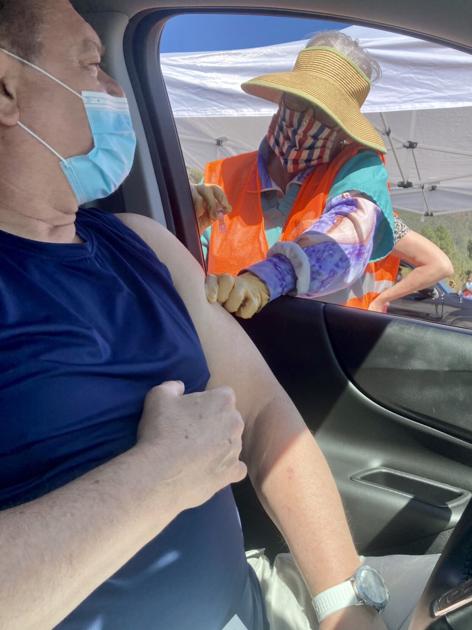
Faster-spreading strains of the COVID-19 virus have caused the start of a fresh spike in cases nationally as states like Arizona have relaxed precautions.
Michigan, Minnesota, Florida, Georgia, Pennsylvania, Texas, New Jersey, New York, California and other states have reversed a months-long decline in new daily cases, with the more easily spread variants accounting for between 50% and 75% of the increase.
The new variants have come ashore in Arizona as well, accounting for 20% to 30% of new cases in recent weeks, according to the Helix national database, which is tracking the rise of the new strains based on fragmentary genetic testing nationally. So far, most of the spread has involved the more easily spread and potentially more lethal B.1.1.7. strain, which forced England into a fresh lockdown and overwhelmed hospitals there. The even-more worrisome strains first detected in Brazil and South Africa have also been documented in Arizona and elsewhere. In the meantime, separate, more easily spread strains have also been detected in Arizona and California.
The variants have helped drive a 14% increase in cases nationally in the past two weeks, with about 73,000 new cases daily. So far, the U.S. has reported 31 million infections and 558,580 deaths.
Epidemiologists said the spread of the variants threatens to cause a new spike, after two months of decline from the record-breaking caseloads in January. As a result, doctors stressed the need to continue social distancing and mask wearing in public until at least 70% to 90% of the population gets vaccinated.
Unfortunately, states like Arizona have rushed to drop mask mandates and other restrictions just as the pace of vaccinations starts to sag. The federal Centers for Disease Control says fully vaccinated people can now safely gather in small groups and even travel. However, the CDC has warned that the large number of unvaccinated people means everyone still should wear a mask in public and avoid large groups with many people who haven’t been vaccinated.
The three approved vaccines provide 85% to 95% protection from both infection and serious symptoms — with virtually no serious side effects. Moreover, good, multi-layer cloth masks also provide 70% to 80% protection, according to a growing body of studies.
Repeated studies have shown wearing masks in public presents no health risk to wearers — but effectively stops the release of respiratory droplets that mostly spread COVID. Lab studies show cloth barriers block most droplets containing the virus and reduce infections in lab animals by 80% or more. Studies in the real-world have also shown that proper use of masks reduces transmission more than 70% in most cases. The combination of widespread vaccinations and widespread use of masks in public would stop the spread of the virus.
That means wearing masks in public can prevent a fresh spike, while public health officials work on convincing 90% of the population to get their shot.
Gila County remains at “high risk” according to national tracking databases. The county as of Thursday continued to report about five new cases per day, a 37% decrease from the average two weeks ago. The county so far has reported at least 6,573 cases — about 12% of the population. Nonetheless, Gila County remains at “high” risk of infection, with 5% of tests still coming back positive. Payson has far more cases than communities in southern Gila County.
Gila County has fully vaccinated about 30% of the population so far compared to 20% statewide. That includes most of those over 65 — the group at greatest risk of death and serious illness. The county has reported just four deaths in the past two weeks.
Statewide, 33% have gotten at least one dose and 20% have been fully vaccinated — still far short of the coverage that would make it safe to gather in groups of people with and without shots and only about a quarter of coverage needed to reach the safety of “herd immunity.” At the current national pace of some 3 million shots per day, we could reach that goal in July. However, experts fear vaccine hesitancy fed by the spread of misinformation may stall progress before then.
Even in Gila County, with its fast start, the number of people lining up for a shot has declined. As a result, the county health department is relinquishing shots distributed by the state to other counties with more demand.
Polls suggest that perhaps a third of the U.S. population remains leery about the vaccine and may not opt to get vaccinated. In addition, the vaccine has not yet been approved for children under 16. This means for the foreseeable future, the country will struggle to get above a roughly 60% vaccination rate, although the states will likely have enough doses to give every adult a shot if they want one sometime in May.
So the virus will continue to circulate for months to come, developing new strains that will spur hospitalizations and deaths among the unvaccinated. Worse yet, the continued evolution of the virus could eventually produce a strain against which the vaccines are ineffective — washing away a traumatic year of hard-won progress.
April 13, 2021 at 07:00PM
https://www.paysonroundup.com/covid-19/new-covid-strains-threaten-to-produce-a-fresh-lethal-peak/article_59ae0fb2-1e0d-5a30-a74b-b14f8205e032.html
New COVID strains threaten to produce a fresh, lethal peak - Payson Roundup
https://news.google.com/search?q=fresh&hl=en-US&gl=US&ceid=US:en

No comments:
Post a Comment